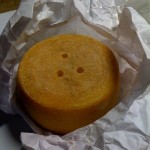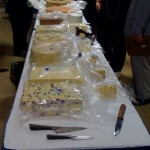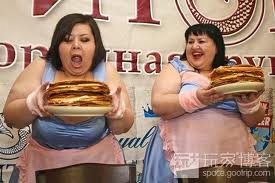Eat
Praise Cheeses!
Tuesday, Nov 20, 2012 5:14 pm
Â
At the Big E fairgrounds this year, a cheese-making competition elevated milky cultures to a high art. But tasting 142 cheese varieties? No worries. NPP’s plucky reporter had an appetite for the challenge….
By Roz Cummins
Â
“Cheese is milk’s leap toward immortality.†– Clifton Fadiman
Imagine you are standing before a Thanksgiving table laden with dish after dish but —   instead of turkey, mashed potatoes, and pumpkin pie — every plate holds a different cheese. Now imagine that you have to taste all 25 of these cheeses, and that you have already tasted more than 60 varieties earlier in the day. Welcome to the world of judging cheeseimaking.
I witnessed just such a sight at The Big E’s cheese competition, a late-August gathering of licensed New England cheese-makers. On the morning of the contest, I took the Mass Turnpike to the fairground, where I drove down the Avenue of States, which was lined by buildings designed to look like miniature versions of the state capitols. Because the judging took place before the fair opened to the public, the avenue was eerily quiet, giving the impression of a deserted Hollywood set that had not yet been struck. Holding the contest in advance of the fair allows organizers to present the medal winners to the public once the fair starts, and manufacturers the opportunity offer their cheeses for sale.
Once inside the room in the coliseum where the competition would take place — a side room tucked beneath the bleachers — I could see that most of the judging teams had already assembled. Serving on the panel of judges were a cheese maker, a cheese monger, an academic expert, two cheese buyers for high-end restaurants, and me. (I am a food writer who has written about cheese.)
Every team had three judges —  a technical judge, an esthetic judge, and a guest judge — and the teams were expected to taste and judge at least 45 cheeses each over the course of the day. My team was charged with tasting cheddars, smoked cheeses and soft varieties, while the other teams took on Swiss-style, washed rind, mozzarella, feta, Colby/Jack/Brick/Muenster/Gouda/Havarti and mold-ripened categories, as well as “Open Class,” in which cheese-makers may choose to place their entries, perhaps to goose the thrill of the competition.
At the end of the afternoon, all the judges would taste the gold medal winners from each category in order to choose the very best cheeses in the competition. There were 142 cheeses in all to judge.
From hard to soft
My team started off with 18 cheddars. Many were fabulous — well-developed flavor, excellent texture, pleasing appearance and aroma — but some were very disappointing. The ones that fell short of the mark tasted extremely bitter and had odd and unexpected textures. Even though 18 cheddars is a lot of taste, at this point in the competition I still had my appetite.
Next we moved on to flavored semi-soft cheeses all-milks. (The all-milks designation means that the cheeses could be made from cow, sheep, or goat’s milk or any combination.) While tasting a fig-flavored cheese in this group, I experienced a foodie first: Neither the base cheese nor the pieces of fig had any flavor whatsoever. The other judges on my team concurred. Chewing a food with no flavor is probably the weirdest culinary experience I’ve ever had.
We also tasted flavored soft cheeses-all milks (as opposed to the semi-softs of the previous category), which were mostly made of goat’s and cow’s milk. Entries included some excellent gold medal-winning goat cheeses and a burrata (a buffalo-milk cheese with a soft rind that, made properly, contains a lovely, gooey center). The burrata was delicious but only garnered a silver medal because its filling was loose and watery.
Â
 It’s okay to smoke
The smoked-cheeses category was my team’s last. Aside from one bitter entry, the samples were very good. I was intrigued by the different tastes that emerged from various cheese styles once they had been smoked. Except for the final tasting of all of the gold medal winning cheeses to determine first and second place, our team was done — and a good thing because my appetite for cheese was now gone.
The only cheeses that remained to be judged, the flavored hard cheeses-all milks category, sat neglected on a table on the other side of the room. Another team was supposed to taste them, but that team was still working away on their previous category.
 “You know,†the technological judge on my team said in a low whisper, “We can’t leave until all the judges have judged the gold medal winners, and we won’t be able to judge the gold medal winners until that category has been judged.†We exchanged glances and agreed to judge the last category even though I didn’t think that I could put even one more piece of cheese in my mouth.
 We took a deep breath, sat down and dug in. Fortunately, the cheeses in the flavored hard cheeses-all milks category were nearly all stupendous. Blueberry Windsordale, Sumac and Black Pepper Eweden, Alehouse Cheddar, and Chocolate Stout Windsordale, were among the many gold medal winners in this category. Elena Hovagimian, the woman who orchestrates the cheese competition, asked my team if it was really possible that we could have given so many cheeses in this category such high marks, but many of them were truly exceptional — and believe me, that’s saying something after a long day of tasting dozens of samples.
Â
Tasting their medal
Finally, it was time to see and taste all the gold medal winners, and that’s when I faced that formidable table of 25 cheese finalists. Each of us ranked our own top three and the organizers of the competition then tallied our rankings to come up with the final top two: Best in Show and Reserve. There was a “sudden death” taste-off for first place between two cheeses, with Best in Show ultimately going to a natural rind cheddar by Grafton Village Cheese Company, and Reserve awarded to a bloomy rind goats’ milk tomme with herbed midline from Ruggles Hill Creamery. For a list of the Gold, Silver, and Bronze medal winners, click here.Â
I was deeply impressed by the skill, knowledge level and commitment of all of the judges as well as the superb organizational skills of the Big E staff and the kindness and generosity of all of the volunteers who helped to produce the tasting. As I headed back to Boston on the Pike, I was glad that I had been given a chance to put my taste buds through their paces and to experience the wide variety of fantastic cheeses produced in New England. I wasn’t in a hurry to eat cheese again any time soon, but it was reassuring to know what amazing choices were out there waiting for me once I got my appetite back.
Roz Cummins is NPP’s food editor. She has worked in every possible permutation of food co-op, natural foods store, and granola-type restaurant. She is currently at work on a book about tea and pastries. Roz can be reached at rozaroni@gmail.com.









Leave a Reply